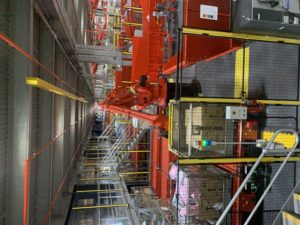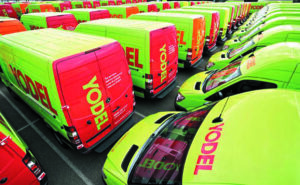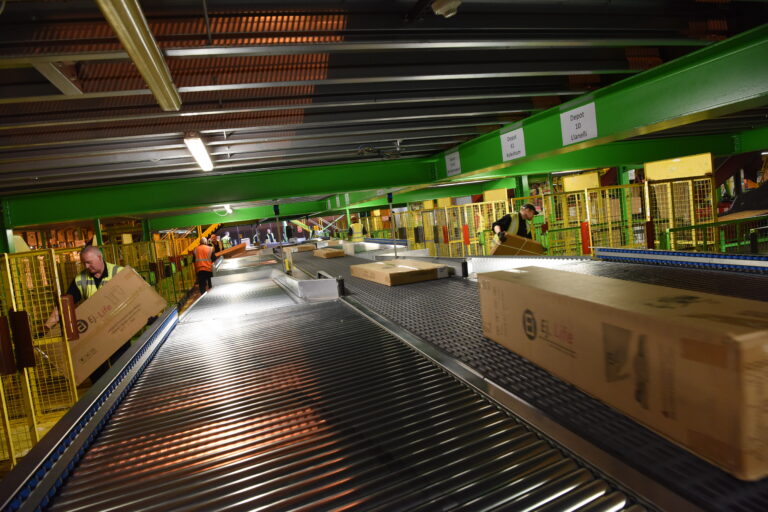Conveyors and sortation systems are the core of intralogistics operations, and their versatility is meeting increasingly complex demands. Johanna Parsons investigates.
Conveyors and sortation systems are the backbone of the warehouse, connecting all the extremities of the intralogistics operation. But there is far more at stake than just moving stuff from A to B. Escalating requirements are stretching many systems, so this technology needs to be more flexible than ever before.
Investment in such a core component of the intralogistics operation will always require deep consideration. Setting up conveyors and sorters can involve sizeable capital outlay, and will influence every other inbound and outbound process. Likewise, how such equipment works will be dependent on exactly what is being processed. So careful planning is required.
“In order to optimise investment, the automation equipment provider has got to spend a significant amount of time understanding a customer’s business and the processes that help drive it,” says Brian Jones, sales director for BEUMER Group Logistic Systems.
“Drawing up first-time automation solutions also requires several key factors to be taken into consideration. You have to look at earnings per item as well as the structure of the distribution network and what the means of distribution are. It is also important to understand the operational cost per item that is being sought,” says Jones.
Stephen Baker, head of solutions strategy at Dematic says there are three fundamental considerations, sorter function, product type, and the required throughput rate.
He says “In most cases the sortation system is there to do one of three things: Distribute received totes or cartons to different parts of a buffer, picking or ASRS system; Enable a batch of picked items to be collated into orders, and then to be packed into parcels, or perhaps loaded onto order pallets; or distribute despatch units to chutes or truck loading docks based on the destination.
“Whichever of these is the case, it will affect both the design of the sorter and also the chute arrangement that is used in conjunction with it, so it’s important to define this up front,” says Baker.
When the requirements have been ascertained, you will need to consider the equipment that would be most appropriate. Hilton Campbell, managing director at Interroll gives an overview. “The first consideration should be, if you need a circular sorter (horizontal), or a vertical sorter, (up and over). A cross–belt sorter can be delivered in both configurations. Shoe sorters can only be supplied in a vertical configuration and a tilt tray only in a horizontal configuration. These are the only real options when weights exceeding 35 kgs and throughputs above 6,000 per hour need to be processed,” says Campbell.
“The shoe or slide sorter has been around for many years, it has both a solid design and track record. The sorters offered today can be equipped with different “shoes” depending on the type of products to sort. This kind of sorter is good for cartons of good quality and plastic bins.”
The tilt tray sorter is perhaps a more familiar option, and Campbell explains that this technology can travel at very high speeds, up to three meters per second. “It is suited for cartons, totes and better for bags. The design of the tray allows for goods that are not the most stable. In my experience I see mostly a tilt tray in airport applications, and in some larger parcel distribution centres. The loads can exceed 35 kgs. One disadvantage is that such a sorter realizes a ‘passive’ discharge, it relies solely on breaking friction between the tray and the parcel when tilting to be discharged to a destination or chute.”
Campbell says that the third option is the cross– belt sorter. “Compared with a shoe sorter it can be offered in both a vertical configuration, slightly deeper than a shoe sorter, or in a horizontal configuration, becoming increasingly more popular. In the horizontal option, the design can be omni-directional, including inclines, declines and it follows the contours of the building. The sorters can be used multiple times and therefore when designed into the process can be used in different stages within the complete solution. A cross–belt sorter offers an “active” discharge, so it gives complete flexibility to the customer.
“If you can induct it by a conveyor or even by hand, it will sort it!” says Campbell.
He says there are two types of cross–belt sorter, electrical or mechanical. “The main difference is how the cross–belts themselves are powered. The mechanical sorter was until recently limited to a speed of 1.8m per second and a weight per carrier of 35 kg. Today, there is now also in additional a High Performance Cross–belt Sorter by Interroll, one that can operate at speeds up to 2.5m per second and can carry loads up to 50kgs. It has maximum throughput of 20,000 items per hour. A mechanical sorter is more cost effective than a electrical sorter,” says Campbell.
“Sortation has the potential to touch every part of your business,” points out Jerome McAllister, technical sales and proposals manager, Conveyor Networks. He says that if implemented effectively, sortation can make the whole material handling operation more efficient and cost-effective. But he reckons this is often dependent on the demands being made by the consumer.
“The warehouse will always be shaped by trends in consumer behaviour and technology. When deciding on a sortation solution, it’s natural for businesses to start with different system applications, but it is more effective to consider the data that will drive the entire sortation design. Analysis of product handled, throughput, unit load, recirculation, budget, space and scalability requirements, will help determine the appropriate sort philosophy and subsequently which sorter you then choose,” says McAllister.
Fast and Reliable
 In terms of consumer trends, retail is the sector that has seen perhaps more change than any other in recent years, with the development of online shopping. The mega omni-channel e-retailers like Amazon have led the way with enterprising new approaches to fulfilment logistics. But the effect has trickled down to even the smallest retailers whose customers have come to expect a certain level of service and speed.
In terms of consumer trends, retail is the sector that has seen perhaps more change than any other in recent years, with the development of online shopping. The mega omni-channel e-retailers like Amazon have led the way with enterprising new approaches to fulfilment logistics. But the effect has trickled down to even the smallest retailers whose customers have come to expect a certain level of service and speed.
“Consumer shopping habits are now having a large impact on how sortation systems are designed,” says Conveyor Networks’ McAllister. “E-commerce fulfilment now dominates space in distribution centres, as retailers need their sortation equipment to be fast and reliable to manage the volume of goods being moved.”
And McAllister says that the challenge goes way beyond just sending shipments out fast “The cost of returns to a supply chain cannot be ignored. Known as the new battleground for retailers to maintain the competitive advantage, well managed returns operations are shown to have a positive impact on customer loyalty.
“Automating your operations improves productivity, traceability and information management. Adding scanning software into the equation, gives the ability to quickly and accurately log the information about the item. The data collected can improve understanding of customer behaviour and drive changes to strategies such as buying, marketing or packaging to improve the cost of sale,” says McAllister.
BEUMER’s Jones concurs that the challenges are defining new ways of working. “Logistics companies already have to deal with a whole raft of individual requirements from different customers.” And he says all pose unique challenges.
“In terms of inventory passing through different channels, for example, similar items are often differently packaged dependent upon the relevant channel. Furthermore, some retailers adopt distinct approaches to the dispatch of individual items of apparel, depending on whether they are going to their stores or are e-commerce items. In the case of the former, sometimes hangers are preferred to minimise the use of store-side labour, while the latter are commonly polybagged without hangers to reduce costs,” explains Jones.
Jones echoes McAllister’s feeling that automation is a key way to deliver the extra levels of traceability and speed that customers now expect. “Retailers are nowadays prioritising service levels, since customers are increasingly demanding next-day delivery as an absolute minimum. Indeed, the majority of logistics businesses now aim to fulfil around 95% of all orders within at least 24 hours. Such levels of service absolutely demand automated solutions if high volume traffic levels are to be handled both quickly and accurately.”
Even the more traditional markets for sortation like postal services are looking to the benefits of integrating automated processes. “Nowadays, there is a consensus of opinion that says introducing a higher degree of automation at the interface between the sortation system and the physical transport to and from the distribution centres would significantly improve the efficiency of an entire operation,” says Jones.
He gives the example of BEUMER’s work with Australia Post at its Brisbane hub. “This facility incorporates robotic ULD inverters, automated singulators, parcel pickers, and loose load trailer operations alongside ergonomically designed operator platforms and devices. In addition, there are high capacity sorting and conveying systems able to handle both large and small parcels that also incorporate full dimension weigh and scan capabilities,” says Jones.
Jones also points out that the different channels retailers now utilise mean completely different business demands and challenges are often processed through the same facilities. E-commerce fulfilment is totally different to preparing goods to be delivered to a store, let alone for wholesale. But there are conveyor and sortation technologies that can address these challenges of blending or separating streams.
“To overcome these differences, larger and more advanced operations can make use of loop sortation and pouch sortation systems. These actively encourage automation and integration of core processes whilst simultaneously sorting multiple flow routes from in-feed through to despatch.”
Dematic’s Baker agrees that the different sortation methods available have decided benefits for particular channels. He says that sorters such as tilt tray (aka bomb bay) or cross–belt sorters are generally ideal for sorting traditional retail orders going to the stores, where the number of destinations is relatively low. “However,” says Baker, “for handling e-commerce orders the sorters will typically have too few destinations to sort an e-commerce batch into individual orders. Each sorter destination therefore has to take a number (say 10-20) of e-commerce orders simultaneously, and an operator (typically a packer) will then manually separate the items into the individual orders ready for packing.”
Baker agrees with BEUMER’s Jones that sorting systems that use bags suspended from hangers are particularly well suited for online orders. “The modern solution to sorting and collation of e-commerce orders consisting of small items is undoubtably the pouch system,” says Baker.
“In this case all batch picked units are inducted into separate bags or ‘pouches’, each of which is hung beneath a conveyor similar to hanging garment conveying technology. The units can therefore be conveyed, buffered and sorted at high throughput rates on the system. Using a series of sortation steps [means that] the units can also be fully sequenced, such that very small orders of two or three items can be linked in the system, and routed together to a packing station. There is therefore no reliance on a specific number of destinations or chutes. In this way no manual separation of orders is required for e–commerce order collation, unlike with more conventional sorters,” says Baker.
So it seems there is a sortation style and a conveyor configuration for every task. Automation is certainly creeping in as a useful adjunct to many conveyor and sortation systems, but the unique requirements of each particular business, and each channel stream within it will determine the appropriate mix. As logistics demands become more complex, the versatility of conveyor and sortation systems will keep them at the core of warehouse operations.
Delivering 75% less handling for Yodel
 Parcel carrier Yodel has reduced its manual handling by 75% following the installation of an “Out of Gauge” (OOG) sortation system from Conveyor Networks, at its Sort Centre in Wednesbury in. the West Midlands.
Parcel carrier Yodel has reduced its manual handling by 75% following the installation of an “Out of Gauge” (OOG) sortation system from Conveyor Networks, at its Sort Centre in Wednesbury in. the West Midlands.
Yodel commissioned Conveyor Networks to undertake the replacement of existing infrastructure with a new automated sortation area, This was to enable it to respond to increasing demand on OOG product sortation.
The new system reduces risk of operator injury, increases efficiency and counteracts potential damages and mis-sorts, which are common when manually handling outsized OOG products.
The system from Conveyor Networks uses Intralox sortation equipment, consisting of Activated Roller Belt technology, providing gentle and precise sorting, which historically would go through a manual process.
Steve Trisic, head of sort operations at Yodel, said: “As a leading parcel carrier in the UK, we needed a reliable system that would give us more functionality to sort OOG parcels. Conveyor Networks has been able to deliver a solution that enables us to process bulky and delicate parcels more easily and efficiently, increasing our capacity and improving the flow of parcels through the sort.”
The new system also deploys routeR, part of imio Software Solutions’ suite of applications, which provides “real time data” tracking of parcel distribution to each chute, ensuring effective distribution performance throughout the system.
Marcus Uprichard, head of business development at Conveyor Networks and imio Software Solutions added: “Typically, sortation of ‘delicate/fragile & misshaped’ products is a manual process, so the automated solution we have provided is rather unique to the UK post & parcel market, and a flagship project for Conveyor Networks.”
Covid-19 Response
Leicester-based BS Handling Systems has invested over £100,000 in an electrostatic sanitisation system designed to combat Covid-19 and other bacterial threats.
Known as the Infection Control Preventative Measures Programme, BS Handling says its service uses specialist equipment, training, innovative chemistry and proven disinfection protocols.
The electrostatic spraying technology employed has an electrode in a dispersal gun that atomises the cleaning fluid. On spraying, positively charged particles are attracted to surface areas, including difficult to reach places, all of which receive an even coating of the antibacterial solution.
Robert Brand-Smith, BS Handling System’s managing director claims, “Since launching the service we have treated over 160 sites. These include warehouses, offices, hotels, banks, retail premises and nurseries. Looking ahead, we currently have almost 100 additional sites booked in so the demand is clearly out there.”
“The time taken to complete a site varies on size, but typically, a 5,000 sq ft facility can be completed in two hours with minimal disruption to business. The site is cleared for working around 10-15 minutes after completion of the process.”
“Both our Covid-19 disinfection services and core storage, conveyor and materials handling businesses are operating fully to support those companies and key organisations still working under lockdown. More importantly, when it is safe to do so, they will be ready to help companies by providing back to work resets to get the economy moving again.
“To assist those most in need, we are also in discussion with a local charity to provide the electrostatic sanitisation service at no cost to them,” says Brand-Smith.
This feature originally appeared in the September edition of Logistics Manager.







